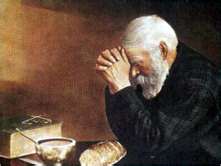
TheDiscipleMD
I first remember seeing it on the kitchen wall of my parents’ farmhouse in the early eighties. I don’t know what it was about that particular painting that captured my attention. Perhaps it was the discouraged look on the old man’s face. His white head bowed down in disappointment at the bowl of gruel and the small loaf of bread before him. He looked like a broken man to me. The meager meal that lay on the hard wooden table in front of him would lead any man to cry out in agony and desperation. I could read his thoughts, “Oh, not this for dinner again!” In fact, the small knife that lay on the table looked like his best opportunity for escape. Yes, that painting gave a tragic view into the life of a badly beaten man.
One day I was at my parents’ farmhouse and the “painting” came up in conversation that I was having with my Dad. He remarked how much he liked it, as it was a reminder to him that we need to be grateful to the Lord for even the most meager of life’s blessings. In the case of the painting, it was a scanty meal. “Well, that’s funny,” I said to my Dad, “because I thought it was a picture of a discouraged old man with his head down in despair at the thought of another pitiful dinner.” My Dad looked at it and laughed. I remember him chuckling as he said, “Well, I guess you could look at it that way!” But now that my mind “was right”, I looked again at the painting and I could see the true message that the artist was trying to convey. It was one of thanksgiving! Much later I found out that it is a famous painting, or photograph turned to paint, called “Grace.” I have since seen “Grace” in many places. It is one of the most famous photographs of the twentieth century. The photographer, Eric Enstrom had this to say about his photograph: “As soon as the negative was developed, he was sure he had something special… a picture that seemed to say, ‘This man doesn’t have much of earthly goods, but he has more than most people because he has a thankful heart.’”
You know how they say there are individuals that look at life as a glass half full or half empty. I found out I had been looking at that painting in a “half empty” mind-set. Suddenly, the discouraged old man, broken and battered, thankless and beaten, emerged as a triumphant man with a thankful heart. Many years ago Dallin Oaks told this story after reading about a devastating hurricane that destroyed thousands of homes in Florida:
“A news account quoted two different persons who had suffered the same tragedy and received the same blessing: each of their homes had been totally destroyed, but each of their family members had been spared death or injury. One said that this tragedy had destroyed his faith; how, he asked, could God allow this to happen? The other said that the experience had strengthened his faith. God had been good to him, he said. Though the family’s home and possessions were lost, their lives were spared and they could rebuild the home. For one, the glass was half empty. For the other, the glass was half full. The gift of moral agency empowers each of us to choose how we will act when we suffer adversity.” (Dallin H. Oaks, “Adversity,” Ensign, Jul 1998).
I like to think that most of us are “half full” kind of persons, but even so, occasionally, all of us find ourselves in a “half-empty” mindset.If we look to be grateful each day for the blessings in our lives, the sun’s rays will feel a little warmer and the spirit of God will penetrate a little deeper into our souls. Indeed, when we see our lives as “half-full,” we need to take another look at His “grace.”


 August 2nd, 2023
August 2nd, 2023  Scott
Scott 
 Posted in
Posted in  E-mail Address:
E-mail Address: